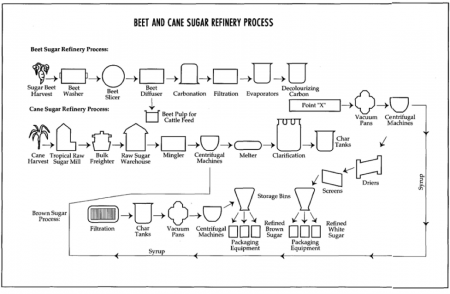15 Sugar (Sucrose)
For the remainder of this section, we will be referring to sugar generally to mean sucrose and its derivatives.
Sugar is a natural food. Chlorophyll, the green colouring matter in plants, is the key to the natural production of sugar. The process used by green plants is called photosynthesis. Plants build all other food substances, such as protein and oil, directly or indirectly from this sugar.
The two plants that yield the most sugar and are commercially grown are sugar cane and sugar beet. Raw sugar is made in large refineries by crushing cane sugar (Sacchrum officinarum) or beet root (Beta vulgaris) to obtain juice. Boiling the juice removes water, and with further processing, unrefined raw sugar is obtained (sometimes also known as panela). Generally, cane sugar is produced by tropical countries and the beet sugar by cooler, temperate areas.
Sugar cane is actually a giant grass that stores sugar in its stalk. Planting the cane is something like planting potatoes. It is grown in warm, moist countries, and cane accounts for approximately 80% of the world’s sugar; the remaining 20% is produced from sugar beet. Brazil and India are the largest cane producers, with Brazil alone accounting for over 25% of the world’s sugar. Other producing regions significant to North America’s sugar supply are Thailand, China, Hawaii, the Caribbean, Philippines, and Australia.
Sugar beet was developed in the early 1800s. Since that time, sugar beet farming has spread to all parts of the temperate climatic zone. A root crop, it is more tolerant of northern climates and is grown as far north as Minnesota and Michigan in the United States. In Canada it was once grown in Alberta, Manitoba, southern Ontario, and Quebec, but today, all beet sugar produced in Canada is grown in southern Alberta.
In countries like Canada, sugar beet plays a very minor role, and the bulk of Canadian refined sugar comes from imported raw sugar from cane sources in South and Central America, Australia, and the Caribbean. Whatever its provenance, sugar is a uniform product of great purity.
Today, the Canadian industry consists of cane sugar refineries located in Montreal, Toronto, and Vancouver, as well as the one remaining sugar beet plant in Taber, Alberta, which processes about 150,000 tonnes of beets each year. These factories are all operated by the same company, Lantic Inc., which resulted from a merger of Canada’s two leading sugar producers, Lantic Sugar Limited and Rogers Sugar Ltd. in 2008. The two companies had worked together as one for a number of years before the amalgamation, and the sugar produced is still marketed under the two brands: Lantic in Eastern Canada and Rogers in Western Canada.
Cane refiners import primary-processed sugar cane called “raws.” By law, this product requires further purification and refining to be sold in Canada, as raw sugar does not meet the Canadian standards for health and hygiene.


